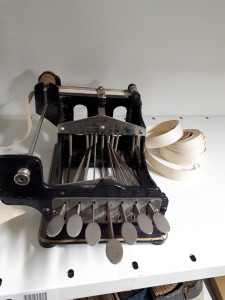by Tristan Clare
The 4th of January marks the anniversary of the birth of Louis Braille, the inventor of braille. World Braille Day was established by the United Nations in 2019 to raise awareness of the importance of braille in the context of education, freedom of expression and opinion, and social inclusion. The UN emphasises the provision of braille and other accessible forms of communication in the Convention on the Rights of Persons with Disabilities.
![]()
As a member of the Executive of the Australian Braille Authority, one of my more pleasurable duties is composing a post to mark World Braille Day. Anyone in blindness and low vision spaces knows that today marks the anniversary of Louis Braille’s birth. Whether you love braille, it isn’t your medium or you’re a user who never thinks much about it, you know it’s World Braille Day and people are going to have things to say about it. It may be the frequent question about whether braille is relevant (yes, yes it is), or the related one about whether accessing material using screenreaders and narrated audio only can be called reading (not going there today).
The subject of my post this year is slightly different. I can’t claim all the credit for this idea, although it is one that I am passionate about. A very articulate post from a Facebook friend got me thinking about it and, with her permission, I want to post the following message. These are my words, not hers, but the subject matter is very similar.
If you’re the parent, guardian, carer or teacher of a child with residual vision, please consider teaching them braille as well as print. As a consumer and producer of braille and as a person with residual vision, I can tell you that having access to both braille and print has been enormously beneficial for me. My knowledge of print means that I can decipher the errors that come from bad scanning or unusual print fonts. My knowledge of braille is not only the foundation of my current livelihood as a braille transcriber, it means that I can read confidently and fluently while maintaining eye contact with an audience, have access to key points for a presentation and curl up with a good book.
If you are teaching small children with low vision to read print, consider giving them access to dual media. The books are visually attractive and they give the student opportunities to learn braille and print simultaneously. Young brains are incredibly elastic and receptive to information.
Also, if you are teaching braille to students who also read large print, be careful about the messages around braille. For instance, if you say “Well you should learn this because you’ll probably go blind in the future”, then the student will view braille as one of the trappings of sight loss, not a reading medium in its own right.
Also, don’t present braille as a second-class reading system to print, or tell students that braille readers are statistically slower than print readers. Regardless of the accuracy of such statistics for people accessing regular-sized print with full sight, it doesn’t apply to large print readers with low vision. Also, if you tell someone that they’re probably going to be a slow reader and behind their peers, it sets up a self-fulfilling prophecy.
I’m definitely not against the teaching of large print. I think all readers, even totally blind people who will never see print on a page, should know the shapes of print letters. It could mean the difference between being able to read a sign with raised lettering independently or needing assistance to do so. Knowing the shape of print can help you decipher that imperfect OCR of an inaccessible document or work out which end is up on a product that uses raised print lettering. Kids with residual vision can and should be taught to read print.
But they should also have access to braille from as early an age as possible. Braille should be normalised, incorporated into fun activities and presented as a respectable reading medium, not a last resort that you’re stuck with if you’re unfortunate enough to lose your sight.


 The International Council on English Braille’s UEB Code Maintenance Committee is responsible for reviewing and further developing Unified English Braille and its official documentation.
The International Council on English Braille’s UEB Code Maintenance Committee is responsible for reviewing and further developing Unified English Braille and its official documentation. Nominations are invited for election to the Executive Committee of the Australian Braille Authority. If required, a ballot will be conducted at the ABA National Meeting, to be held on Saturday 2 May 2020 at Bayview Eden, 6 Queens road, Melbourne, Australia.
Nominations are invited for election to the Executive Committee of the Australian Braille Authority. If required, a ballot will be conducted at the ABA National Meeting, to be held on Saturday 2 May 2020 at Bayview Eden, 6 Queens road, Melbourne, Australia.
